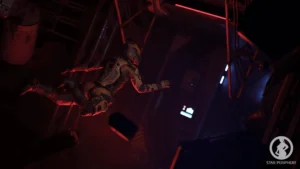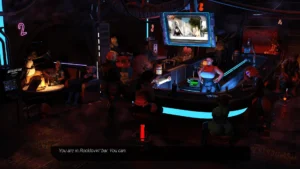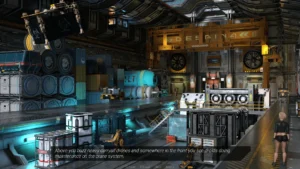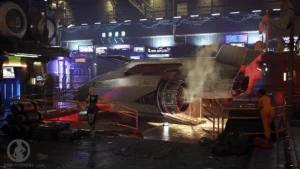
Star Periphery
Play Star Periphery
Star Periphery review
A Deep Dive into the Gameplay, Story, and Features of Star Periphery
Star Periphery is a captivating sci-fi visual novel that immerses players in a futuristic space setting filled with rich storytelling and complex characters. This game stands out for its choice-driven narrative and atmospheric design, offering a unique blend of exploration and interaction. Whether you’re new to the game or looking to deepen your understanding, this article will guide you through its key elements, gameplay tips, and what makes Star Periphery a memorable experience.
Understanding Star Periphery’s Gameplay and Narrative
Ever feel like you’re just along for the ride in a story, watching events unfold on a set track you can’t influence? 🤔 I know I have, and it’s the main reason the Star Periphery gameplay loop hooked me from the start. This isn’t a passive experience; it’s a conversation with the game’s universe. Your decisions, from the seemingly trivial to the morally monumental, are the engine that drives everything forward. The core of the Star Periphery story is a mystery waiting to be unraveled, but you hold the scalpel, deciding which threads to pull and which to leave tangled.
At its heart, this is a masterclass in choice-driven narrative. It remembers your every action, your every whispered confidence and shouted defiance, weaving them into a tale that feels uniquely yours. This level of interactivity is what transforms a simple visual novel into a deeply personal journey through the stars. ✨
### What Makes Star Periphery’s Story Unique?
Forget the standard “chosen one” trope. 🚫 The Star Periphery story is unique because you aren’t a galactic savior; you’re an information broker, a slicer of data, and a purveyor of secrets trying to carve out a life on the fringes of civilized space. Your value isn’t in your combat skills but in your wit, your charm, and your ability to talk your way into (or out of) anything. This premise immediately grounds the narrative, making your rise to prominence feel earned through cleverness rather than destined by prophecy.
The plot revolves around a mysterious signal emanating from the uncharted edges of the galaxy, a siren’s call that promises untold knowledge or unimaginable peril. What truly sets it apart is its semi-linear structure. While the central mystery provides a guiding light, how you choose to investigate it—who you align with, what risks you take, which leads you prioritize—is entirely up to you. This approach to Star Periphery exploration means no two players will uncover the truth in quite the same way or order.
The richness of the world is unlocked through its incredible cast of characters, each with their own hidden agendas, fears, and desires. Uncovering plot details isn’t just about finding datapads; it’s about mastering the interactive dialogue Star Periphery is built on. A casual drink with a cynical mercenary in a dusty bar might reveal more about corporate espionage than any stolen file. I remember once choosing to help a minor character with a seemingly insignificant personal problem, only to have them provide a crucial piece of intelligence hours later that completely bypassed a dangerous confrontation. It’s these organic connections that make the world feel alive and reactive.
To understand how these systems work in harmony, here’s a breakdown of the key mechanics:
| Gameplay Feature | How It Works | Impact on Story Progression |
|---|---|---|
| Dialogue Trees | Conversations offer multiple response options, including persuasive, aggressive, sympathetic, or deceptive approaches. | Builds (or destroys) trust with characters, unlocking new quests, information, and potential alliances. A failed persuasion check can permanently close a story path. |
| Relationship System | A hidden metric tracks your standing with every major character based on your choices and completed tasks for them. | Determines which characters will aid you in critical moments, offer unique sidequests, or even become potential antagonists. High loyalty can reveal a character’s deepest secrets. |
| Skill Checks | Certain dialogue options or actions require a high enough level in a specific skill (e.g., “Tech Aptitude,” “Street Smarts”). | Allows you to bypass obstacles or uncover hidden information. A high “Observation” skill might let you spot a lie, altering the entire course of a conversation. |
| The Codex | An in-game log that automatically updates with lore, character profiles, and mission details based on your discoveries. | Your primary tool for keeping track of the complex narrative. Missed dialogue can lead to gaps in the Codex, leaving you less prepared for future decisions. |
### How Player Choices Shape the Game
This is where the magic happens. ✨ The promise of multiple endings Star Periphery delivers isn’t just a binary “good or bad” finale; it’s a spectrum of conclusions that reflect the sum of your actions. The game doesn’t have traditional “game over” screens. Instead, a poor choice might lead you down a darker, more difficult, yet narratively fascinating branch of the story. You live with the consequences, and that makes every decision weighty.
Let me give you a concrete example from my playthrough. Early on, I was tasked with retrieving a sensitive package. I had three options: pay the exorbitant fee demanded by the holder, stealthily hack their terminal to forge a transfer, or threaten them with information I’d learned about their shady past.
- I chose to threaten them. It worked, and I got the package for free. 🎉
- However, that character later aligned with a faction that became my enemy, and they remembered my aggression, making a later negotiation much harder and ultimately costing me a valuable ally.
- A friend of mine chose the hacking route. They succeeded but left a digital trace. This trace was later found by a corporation, which put a bounty on their head, adding a constant layer of tension and new, unplanned missions to their playthrough.
This is the beauty of the choice-driven narrative. A single decision ripples outward, affecting character relationships, available locations, and even the options presented to you hours later. The path to the multiple endings Star Periphery offers isn’t decided by one big choice at the end, but by hundreds of small ones you make throughout the entire game. Do you prioritize the truth at any cost, or is stability more important? Do you value individual lives or the greater good? The game forces you to answer these questions not through a menu, but through your actions.
My advice? Don’t savescum! 🤫 The first time through, commit to your choices. The most memorable stories are often the ones where things go “wrong.” Seeing how the narrative adapts to your failures is just as compelling as witnessing your successes.
### Exploring the Game’s Themed Locations
The setting is a character in itself, and the themed locations Star Periphery built are nothing short of breathtaking. 🪐 This isn’t a generic sci-fi backdrop; each area is a meticulously crafted environment that tells its own story and caters to specific aspects of the Star Periphery exploration fantasy.
Your journey will take you from the neon-drenched, rain-slicked streets of Veridian Prime, a cyberpunk metropolis where corporations rule and information is the ultimate currency. Here, the gameplay focuses on social maneuvering, hacking, and navigating the intricate web of upper-class politics. The atmosphere is thick with synthwave music and the constant hum of data traffic.
Then you might find yourself on the dusty, wind-swept red plains of The Rust, a lawless frontier outpost built from scavenged ship hulls and desperation. The vibe shifts completely. Here, Star Periphery exploration is about survival, dealing with rugged independents, and braving the dangerous ruins of a long-dead civilization that litter the landscape. The music is more ambient, with lonely guitars and the howl of the wind.
Perhaps the most awe-inspiring of all the themed locations Star Periphery has to offer is the Abyssal Remnant, a derelict generation ship adrift in a nebula. This location is pure cosmic horror and wonder. The gameplay inside shifts to environmental puzzle-solving and uncovering the terrifying truth of what happened to the ship’s crew, with audio logs and eerie visuals painting a haunting picture.
This variety is crucial. It means that Star Periphery exploration constantly feels fresh. You’re not just clicking to the next conversation; you’re traveling to distinct worlds, each with its own unique challenges, characters, and narrative tone. Uncovering the secrets of these locations often requires you to use the skills you’ve built and the alliances you’ve forged, tying the entire experience together into a cohesive and utterly immersive sci-fi adventure. Your choices determine which of these worlds you see more of and which stories you become a part of, making your personal journey through the stars truly your own. 🚀
Star Periphery offers a richly detailed sci-fi visual novel experience that rewards exploration and thoughtful decision-making. Its engaging narrative, combined with immersive environments and dynamic character interactions, creates a game that invites players to return and discover new outcomes. Whether you enjoy deep storytelling or interactive gameplay, Star Periphery provides a unique journey through space that is both entertaining and memorable. Dive in and explore the many paths awaiting you.



















